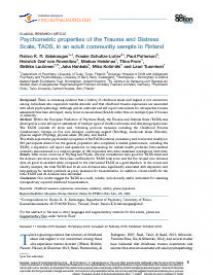Psychometric properties of the Trauma and Distress Scale, TADS, in an adult community sample in Finland
Background: There is increasing evidence that a history of childhood abuse and neglect is not uncommon among individuals who experience mental disorder and that childhood trauma experiences are associated with adult psychopathology. Although several interview and self-report instruments for retrospective trauma assessment have been developed, many focus on sexual abuse (SexAb) rather than on multiple types of trauma or adversity.
Methods: Within the European Prediction of Psychosis Study, the Trauma and Distress Scale (TADS) was developed as a new self-report assessment of multiple types of childhood trauma and distressing experiences. The TADS includes 43 items and, following previous measures including the Childhood Trauma Questionnaire, focuses on five core domains: emotional neglect (EmoNeg), emotional abuse (EmoAb), physical neglect (PhyNeg), physical abuse (PhyAb), and SexAb.
This study explores the psychometric properties of the TADS (internal consistency and concurrent validity) in 692 participants drawn from the general population who completed a mailed questionnaire, including the TADS, a depression self-report and questions on help-seeking for mental health problems. Inter-method reliability was examined in a random sample of 100 responders who were reassessed in telephone interviews.
Results: After minor revisions of PhyNeg and PhyAb, internal consistencies were good for TADS totals and the domain raw score sums. Intra-class coefficients for TADS total score and the five revised core domains were all good to excellent when compared to the interviewed TADS as a gold standard. In the concurrent validity analyses, the total TADS and its all core domains were significantly associated with depression and help-seeking for mental problems as proxy measures for traumatisation. In addition, robust cutoffs for the total TADS and its domains were calculated.
Conclusions: Our results suggest the TADS as a valid, reliable, and clinically useful instrument for assessing retrospectively reported childhood traumatisation.
12/07/2016. Ontleende ontsluiting: Wouter | 7 | maart | 30062
http://www.ejpt.net/index.php/ejpt/article/view/30062


